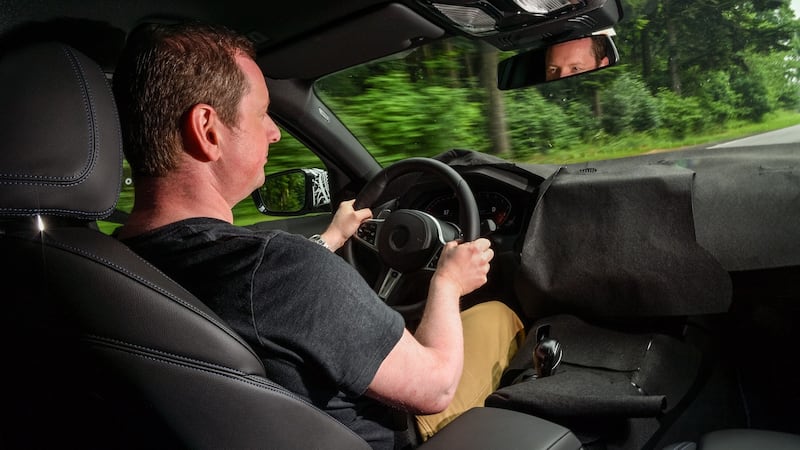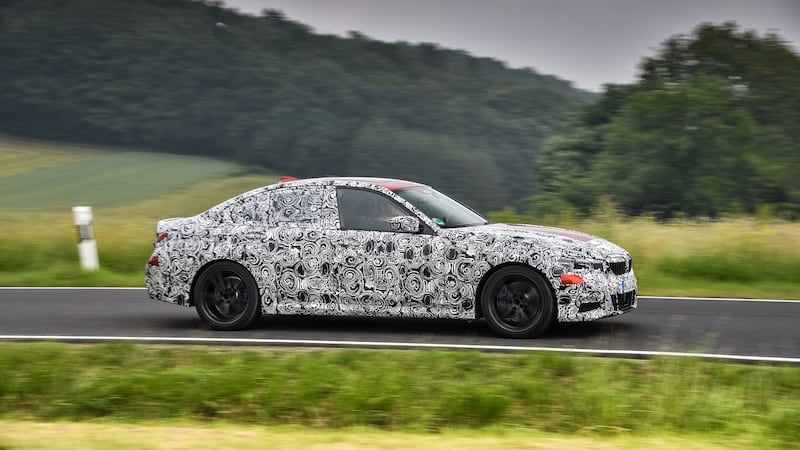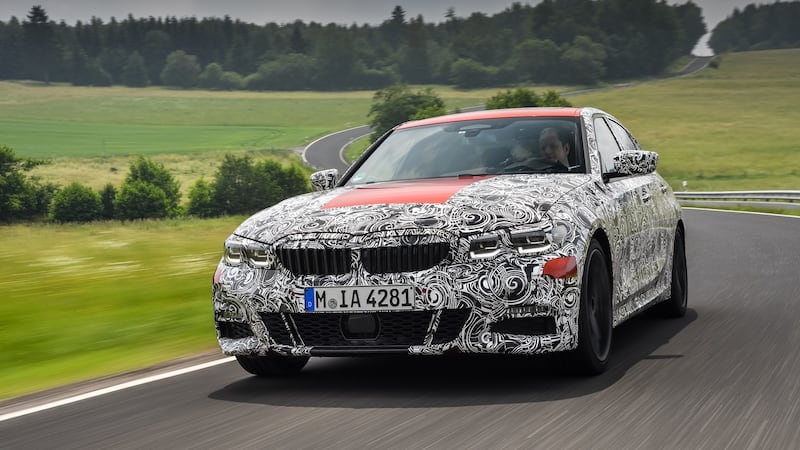We’re all used to seeing cars in camouflage wrap, these days. Instead of using bin bags and lots of duct tape, as was the case once, car makers now try to foil the work of spy photographers with tight-fitting vinyl wrap, splattered with blanc-and-white zig zags in the manner of a first World War battleship.
It’s effective, so much so that car makers themselves have started releasing official-unofficial photos of such cars to whet our appetites.
My appetite is not so much whetted now as it is soaked thanks both to the unexpectedly close proximity of the new BMW 3 Series, still covered in its dazzle camo, and the sheer volume of water tumbling from the sky.
0 of 3
We are adjacent to the famed Nurburgring race track in north west Germany, close to the Belgian border. The Eifel Mountains amid which the track lies are famed for their ability to anomalise the weather, and they're really living up to their rep today. While the rest of Europe toasts in a heatwave, we're bailing out the garage in which the 3 Series sits.
This is the G20, the seventh generation of 3 Series since the 1975 original, but in reality it's the heir to a lineage that stretches all the way back through the 02 series cars and to the 'Neue Klasse' 1500 saloon of 1962.
It has for decades been king of the hill when it comes to (relatively) affordable, sporting, premium cars which just happen to be outrageously good fun to drive, but that is a crown which has slipped a little of late. Not because of any lax performance on BMW’s part, but because the competition has become so much better, so much more talented, and because the world has gone SUV nuts.
At BMW's Nurburgring engineering centre, the 3 Series is still the king, and it's good to be the king – judging by the sheer loyalty of its subjects
Does the explosion in SUV sales, and BMW’s own ever-expanding stable of such cars (we already have X1, X2, X3, X4, X5, X6 and X7 is coming soon) mean that the 3 Series has become less important, both to customers and company?
Not around here, it hasn’t.
Here, at BMW’s Nurburgring engineering centre, the 3 Series is still the king, and it’s good to be the king – judging by the sheer loyalty of its subjects.
"We sold 400,000 of them last year, in the last full year of this model, so it's not doing too bad. One in every five BMWs is a 3 Series, so yes we love our SUVs and they sell well, but the 3 Series is BMW," Kai Lichte, BMW's head of product communications department, tells The Irish Times.
His colleagues agree, and while you would expect them to do so, to put the best corporate foot forward when confronted with a journalist wielding a notepad and pen, the smiles as they discuss the car appear totally genuine.
One line
"For sure, the SUVs are important now, and we have some very good ones" Jurgen Brack, the head of functional design, driving dynamics for BMW says. "But if you ask anyone what is a BMW, what defines the brand? They say 3 Series. Maybe sometimes 5 Series too, but almost always 3 Series."
The new 3 is of course closely related to the 5 Series (and the X3, the X4, the 7 Series etc etc) because it uses the same CLAR platform, but according to BMW, the physical platform is becoming less and less important. What’s crucial now, it seems, is to give the cars common hard-points (mostly the distances between major components such as the front bulkhead and the front wheel) so that multiple models can be built on one line in one factory, and that the electronic architecture is shared. So the 3 is not merely a shrunken 5, and the 5 not just a bloated 3.
Peering beneath the camo tape, the exterior of the 3 looks generally evolutionary, with some interesting details. We won't see it in full for a bit yet, but there are exceptionally slim headlights with half-moon hexagons for their LED highlights, and what appears to be a more sculpted rear end than that of the current car, rather similar in profile to that of the Alfa Romeo Giulia.
The cabin sticks to a familiar layout (well, what we could see beneath layers of concealing felt fabric) but again with new details. There’s a new all-digital instrument pack, with main dials that sweep around the outside edges, and which have a faintly retro feel to them.

The centre console and screen look evolutionary, but some of the switches and buttons are quite different to what’s been used before, and even on this development prototype look and feel a little more expensive. Space, on this subjective judgement, seems fine – not Skoda Superb roomy or anything, but with a little more space than you’d find in the current car.
That’s thanks to the G20 being a little larger in most major dimensions, but it is lighter in spite of that. BMW says that it’s around 55kg to the good, thanks to a Weight Watchers regime for every single component, rather than trying to save large amounts on one or two major bits.
The only technical details we’ve been given so far relate to this 330i version, which gets an extra 6hp or thereabouts for its 2.0-litre turbo four-cylinder engine (which should bring it to around 257hp) and a more significant 50Nm extra of torque (adding up to around 400Nm - very diesel-like).
Emissions and fuel economy are expected to be around five per cent better than before, which should mean Band C emissions and close to 50mpg on the combined fuel economy cycle.
Base models will get three-cylinder turbo engines, fuelled by both petrol and diesel, and there will be two plug-in hybrid iPerformance models, with little and large power outputs, and as much as 80km range on a single charge of the battery. Those arrive ahead of an all-electric model.
Hydraulic suspension
On the chassis front, BMW appears to have taken some inspiration from Citroen, as it's fitted the 3 Series with hydraulic suspension stops. These replace traditional solid bump-stops, and instead allow extra suspension compression into a fluid-filled cylinder, which then gives superior rebound control as the spring and damper recover from the bump.
That’s combined with lower, firmer spring rates for M-Sport cars, as well as the option of an electronically-controlled differential at the rear, which is basically a less feral version of the one you’d find in a high-performance M3.
Does all of that gel successfully together? Boy, does it ever.
The roads around the Nurburgring are streaming wet, and rather similar in character to the race track itself – mostly smooth, occasionally giving into bumps, and spearing endlessly between green-and-brown strobes of passing trees. With not much grip to spare, you’d expect a 400Nm rear-drive car to be a bit of a handful, but actually the 3 Series feels imperious in these conditions.
Much of that is down to the steering. We spent a session with Mischa Bachmann, whose business card reads 'Integrated Application BMW Midsize Series' but who we're going to call Steering Wizard. During our test drive, Mischa sat in the passenger seat, with a chunky laptop balanced on his knees, constantly tapping and twiddling.
As he did so, the steering in our hands lightened up and weighted down, speeded up, and slowed down. The idea was to show how versatile the new electric power steering system can be, but also to demonstrate how good it is at telling you what’s happening under the front tyres.
Since electric power assistance systems (EPAS) were first introduced, they have been accused (rightly) of smothering steering feel, and robbing both driving enthusiast and driving agnostic of much-needed feedback from the front wheels.
Well, those accusations now end – BMW has managed to create an EPAS that feels like an old-school hydraulic power steering set up. It’s no exaggeration to say that it bursts with feel, even in the low-grip conditions of our rainy test, constantly chattering a morse code of messages from the front tyres to your palms and fingertips. It is quite bewitching, actually.

The jury is still out on those hydraulic suspension stops, though. German roads are legendarily smooth, but on the bumpy sections we found (some of which looked and felt like rippled corduroy) the 330i still felt quite firm, even jiggly. Mind you, all of the cars we drove were on the harder M-Sport suspension, along with 19-inch rims and runflat tyres, so let us try a version on standard springs and wheels before coming to a conclusion.
Glorious silence
Refinement has most definitely been improved. On a stretch of high-speed Autobahn, surfaced with rough concrete, we would have expected the tyre roar on an outgoing F30 3 Series to have more or less taken our heads off. The G20, in relative terms, glided over it in glorious silence.
For the ultimate in handling tests, though, we were invited onto the Nurburgring itself, and asked to follow Thomas Kafer, head of integrated applications at BMW and the man primarily responsible for the way the 3 Series drives and feels, around for a couple of laps. He would be in a rapid M2. We would be in the 330i. Now, Thomas is an amiable guy, who loves his work, and he can seriously pedal a car, and the M2 took off like a shot. With the 330i in Sport Plus mode, and the rain and conifers closing in around us, we headed into the Green Hell to try and keep up…
It was hilarious. Forget objective handling assessments, this was about survival, and controlling (or trying to at any rate) a staccato series of slips and slides, both M2 and 330i barrelling broadside in formation through many of the ‘Ring’s infamous corners.
A car that can tackle the Nurburgring with such easy-going insouciance, yet cruise quietly down the Autobahn at high three-figure speeds is clearly one of some talent
It’s a 20km lap around, so there was plenty of opportunity for disaster, but even in this sluicing conditions, the 3 Series looked after us. Breach the limits of grip (not hard in this weather) and the 330i would push wide into gentle understeer at first, before slipping into a four-wheel drift of equally gentle oversteer, easily controlled, and with the electronics working overtime to help us gather it all up. Switch all the electronic aids off, and it would probably have been an absolute riot, but sheer self-preservation prevented us from doing that.
A car that can tackle the Nurburgring with such easy-going insouciance, yet cruise quietly down the Autobahn at high three-figure speeds is clearly one of some talent, and it’s precisely why so many car makers set up shop here to work on their chassis and handling characteristics.
The 330i did it with such aplomb, though, that it’s hard to see it as being anything other than the class champ when it comes to steering and road-holding. It feels so much more alive, so much more responsive, both than its immediate predecessor, and any rival that doesn’t wear a high-performance AMG or RS badge.
In fact, I think Mercedes may have to seriously consider fitting the steering rack from its AMG models to the standard C-Class if it’s to even hope of matching the 3 Series’ new set-up.
We’ll have to wait a while before delivering a full verdict on looks, quality levels, cabin design, and of course value for money, but those thoughts are for another day. Right now, we have a soaking wet race track, a low-slung, turbocharged, rear-drive saloon, and one more lap to go. Forget the SUVs, this is BMW.
















